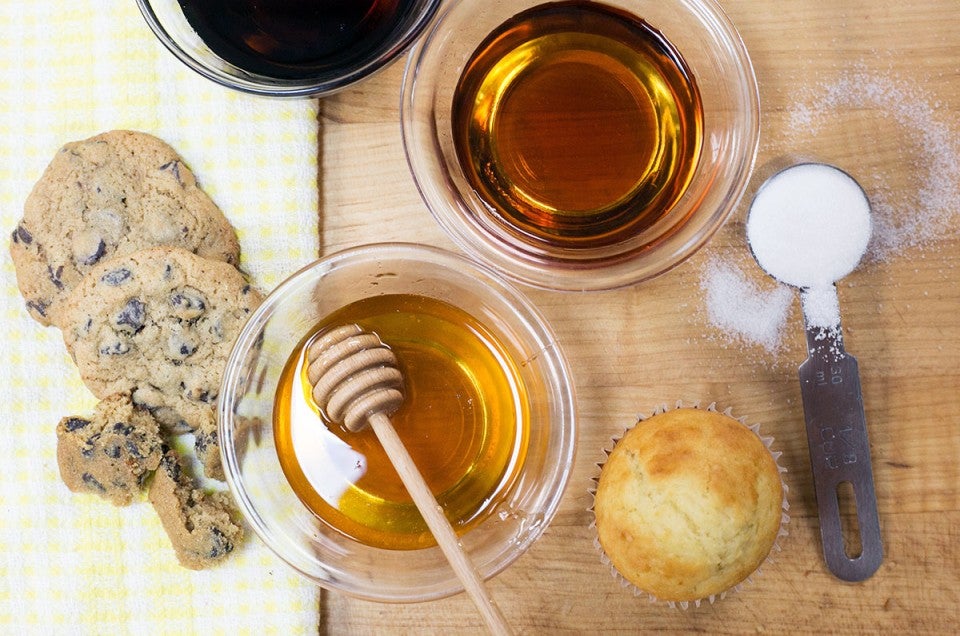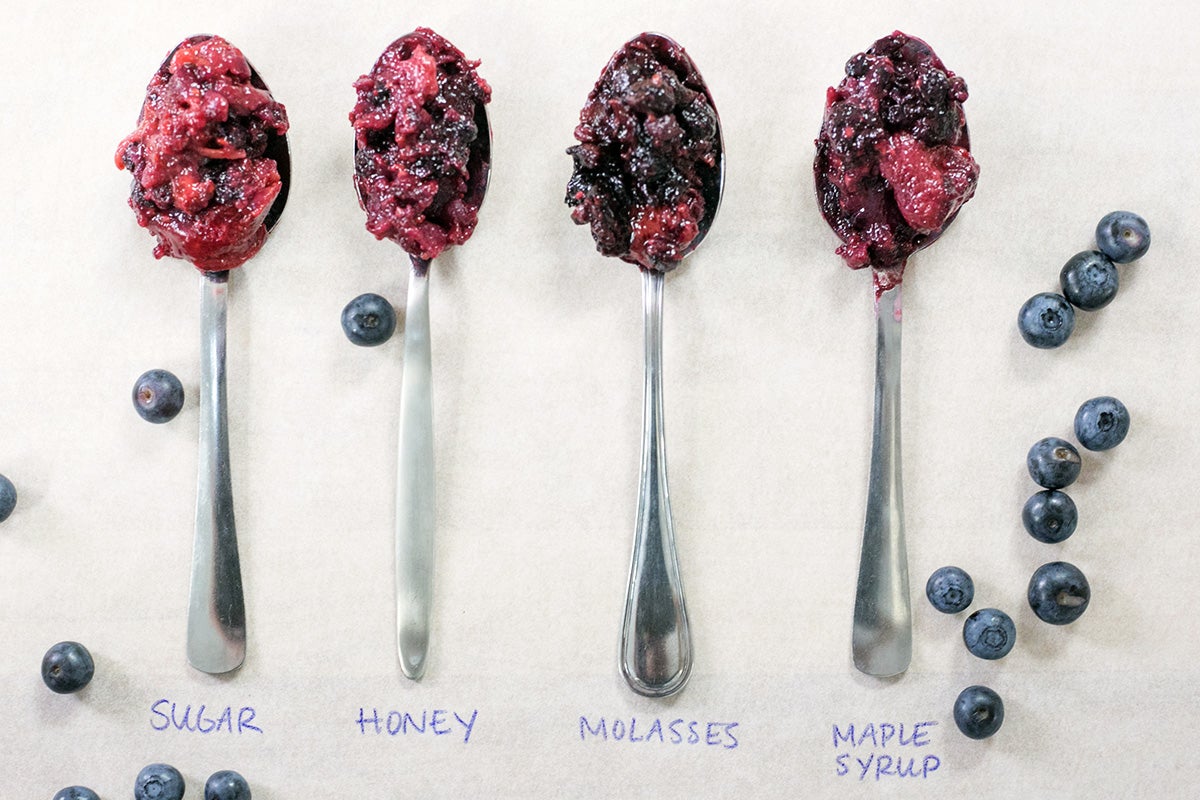


Are you ready to think beyond white granulated sugar? We are. The truth is, sugar comes in many flavors and forms, including liquid. Certain less-processed liquid sweeteners are packed with complex, layered flavors that lend themselves perfectly to baking. But changing a favorite recipe from using dry to liquid sugar can feel daunting.
This is where we come in: we're here to ease your baking fears with some tips that unlock the unique taste and moist texture that comes from baking with liquid sweeteners.
Honey, maple syrup, and molasses are three liquid sweeteners commonly used in baking. They're easily accessible and also delicious, so we're focusing on these ingredients. If your favorite liquid sweetener isn’t in this lineup, don’t fret — our findings can be applied to other sweeteners, too (although without testing, no guarantees).

Let’s take a closer look at these three ingredients so you know what to expect when baking with liquid sweeteners.


Note: don’t be fooled by “fake” maple syrup, where the primary ingredient is corn syrup. Its sweetness dissipates in baking, so reach for real maple syrup.


Each sweetener is unique and changes baked goods in a slightly different way. Here’s what you need to know when using them to replace the sugar in your recipe:
Honey is sweeter than sugar, so you can use about 3/4 the amount of honey when making your substitution (e.g., for 1 cup of sugar, use a generous 3/4 cup of honey). Decrease the liquid by 3 to 4 tablespoons per 1 cup substitution. No added liquid in your recipe? Add about 3 to 4 tablespoons of additional flour for every cup of honey used (about 1 tablespoon per 1/4 cup).
Tip: Don’t use honey in recipes that need to be baked at over 350°F; it scorches.
Maple syrup is about as sweet as sugar, so you can replace it using an equal amount of syrup (e.g., for 1 cup of sugar, use 1 cup of maple syrup). Decrease the liquid by 3 to 4 tablespoons per 1 cup substitution. The same rule applies here if there’s no liquid called for in the recipe: add about 1 tablespoon of additional flour for every 1/4 cup of maple syrup used.
Tip: Make sure you use room temperature maple syrup, especially if baking with butter. Cold syrup can cause the other ingredients to clump.
Use the same approach when substituting molasses: replace the sugar with an equal amount of molasses by volume (e.g., for 1 tablespoon of sugar, use 1 tablespoon of molasses). Adjust the liquids/flour in the same way, adding 1 tablespoon of flour for every 1/4 cup of molasses used if there's no liquid added to the recipe; otherwise reduce it accordingly. Note that molasses does tend to be more robust in flavor than maple syrup, so it’s best used in small quantities or combined with other sweeteners.
Tip: Very dark molasses (blackstrap) can turn bitter when baked, so save it for savory applications.

Keep in mind you can adjust the amount of liquid sweetener to meet your taste preferences. Most recipes can handle at least a 10% to 25% reduction in sugar, which holds true when you’re baking with liquid sweeteners too. (For details on how to reduce sugar in baking, check out this series of articles.)
OK, let's start baking with liquid sweeteners!

We picked a few of our favorite recipes to see happens when we use liquid sweeteners to replace the sugar in some typical types of baking. We tested many variations of muffins, bread, pie, cookies, and cake — here we share some of our most successful substitutions.
Don't feel limited by the pairings below. You can expect similar results from whatever liquid sweetener you use, with slight differences in flavor and color.

Basic Muffins made with molasses: the dark golden color of the muffins is stunning. They rise higher than expected and bake quicker than the original version. They receive a 10 for appearance and have a unique, malty flavor. They're not very sweet, so next time I'd sprinkle some sparkling sugar on the top for extra sweetness and shine.
The verdict: Muffins made with liquid sweeteners will rise nicely and have a slightly more coarse crumb.

Walter Sands' Basic White Bread made with honey: yeast breads might just be the easiest recipes to adapt when baking with liquid sweeteners. With just a few tablespoons of sugar called for in the original recipe, there's no real difference in flavor, crumb, or rise between the two loaves.
The verdict: Yeast breads made with liquid sweeteners may brown faster than those made with sugar but will be quite similar to the original version.

Mixed Berry Pie made with each of the three liquid sweeteners: honey, molasses, and maple syrup. The molasses-sweetened version is quickly out of the running; it has a strange, off-putting color and isn’t quite sweet enough. The flavor of honey pairs best with the berries, while the maple syrup version doesn’t seem all that different from the original.
The verdict: Liquid sweeteners thin the consistency of pie filling, so increase your thickener by 10% to 25%, depending on your preference.

On to another serious subject: cookies! Since cookies can vary widely in texture, we decide to test two different kinds to see how baking with liquid sweeteners affects both a soft and a crispy cookie. You can expect other liquid sweeteners to produce similar results — we're simply sharing our favorite combinations here.

Soft Cookies made with maple syrup: they have a rich, almost brown sugar-like flavor and are super moist. They're darker in color and have some small holes on the surface. Their unique, maple-y flavor make my taste buds sing. Bonus: the maple syrup-sweetened cookies stay pleasantly fresh longer than expected, about five days.
The verdict: Using liquid sweeteners in soft cookies will make them slightly crumbly and cakey; they may also spread more than the original version.

Crispy cookies made with molasses: they spread quite a bit during baking, and so does the batch made with sugar. Both end up being very thin, but the cookies made with sugar become crispy once they cool. For people who don’t like overly sweet treats and enjoy a tender cookie, molasses for sugar might be the perfect swap to make.
The verdict: Crispy cookies made with liquid sweeteners will start soft and remain tender, even after one to two days.
 Baking with liquid sweeteners in cake
Baking with liquid sweeteners in cakeLike cookies, we decide to test two different kinds of cake: one that uses the creaming method and another that’s a simple stir-together, oil-based cake. We use honey for these two tests, but you can use whatever liquid sweetener you think will pair best with the flavors in your cake.

Creamed cake made with honey: it's surprisingly phenomenal! Our research tells us using honey (or any liquid sweetener) to make a creamed cake is going to be a flop. It’s commonly stated that liquid sweeteners aren't reliable substitutes in recipes that call for creaming the butter and sugar together. Since liquid sweeteners don’t have a granular structure, they don’t create the tiny air pockets that make baked goods light and fluffy.
Regardless, the combination of honey, vanilla, and almond extract is magical. It bakes much darker than the original version, but still has an attractive look with a notably flat top — perfect for topping with fresh berries!
The verdict: Baking creamed cakes with liquid sweeteners can be risky but rewarding; expect your cake to be slightly more dense, but also lusciously moist and delicate, too.

Oil-based cake made with honey: it turns a pleasant chestnut brown because of the reaction between the acidic honey and the Dutch-process cocoa powder. The fragrance of honey and chocolate together is novel and intriguing to say the least. This cake, like some of the other baked goods made with liquid sweeteners, has small pin holes along the surface.
Why the holes? The slightly acidic nature of liquid sweeteners like honey creates a more elastic gluten network. The air bubbles in the batter expand as the cake bakes and eventually burst through the top of the cake, creating lots of teeny, tiny holes. (Don't worry, it doesn't take away from the presentation or intriguing flavor of the baked goods.)
The verdict: Baking with liquid sweeteners makes oil-based cakes more crumbly and delicate, as well as super moist.

To make the most of liquid sweeteners in baking, here’s what you need to remember:
Finally, remember that these tests are examples of the many possibilities that await — mix and match your favorite liquid sweeteners and recipes, expecting similar general results but unexplored nuances in flavor and texture.
We hope you feel encouraged to experiment with recipes and your sweetener of choice. If you stumble across any fantastic combinations when baking with liquid sweeteners, let us know in the comments, below.
Thanks to Anne Mientka for taking the photographs for this post.